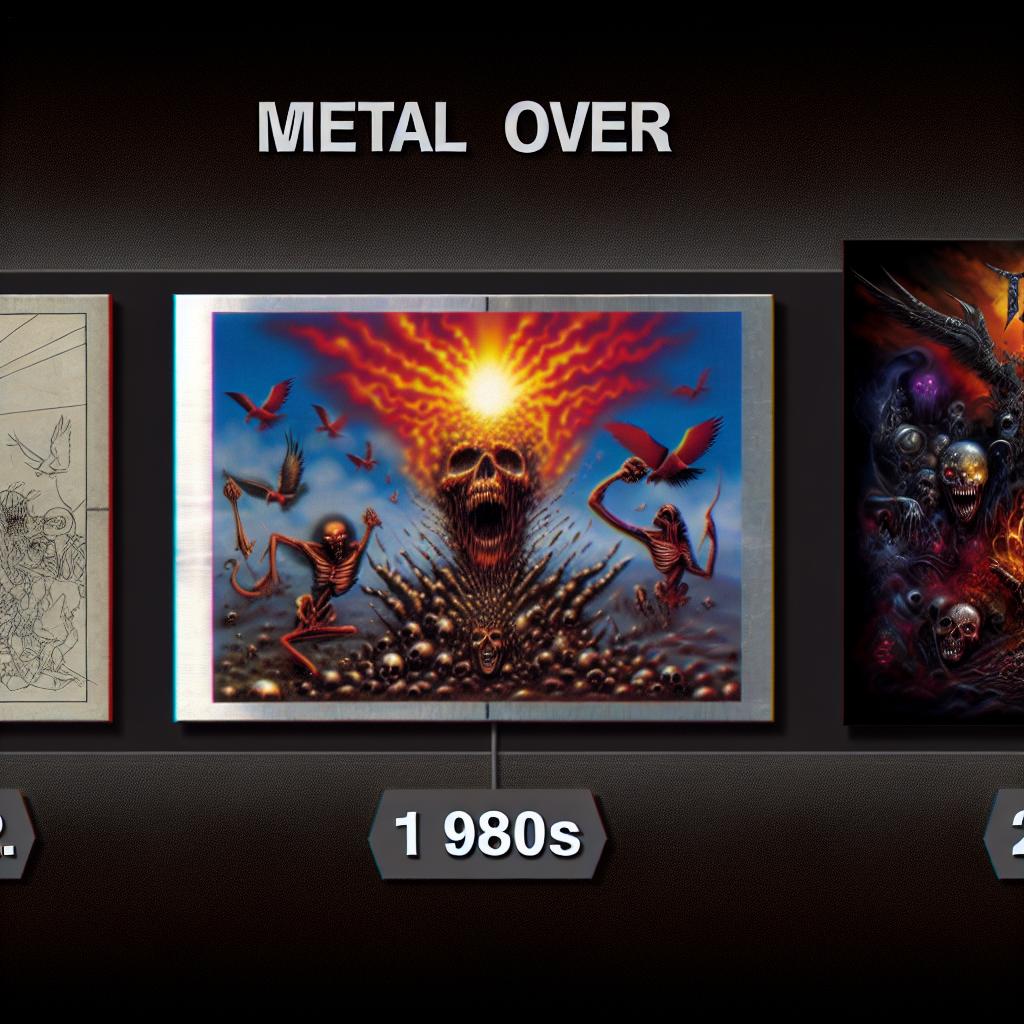The Evolution of Metal Album Cover Art

The Evolution of Metal Album Cover Art
Metal album cover art has witnessed substantial transformations since the genre’s birth in the late 1960s and early 1970s. As metal music has progressed over the decades, so has its visual representation, which accurately mirrors broader cultural and artistic movements.
The Early Years: 1970s
In the formative years of heavy metal, bands such as Black Sabbath and Led Zeppelin laid the groundwork for the genre with their distinctive cover art. During this period, album artwork predominantly displayed dark and mystical themes, frequently employing bold colors and intricate designs. A prime example is Black Sabbath’s Paranoid, whose cover used simple yet eerie visuals to capture the essence of the music. Such artwork during this era served as a precursor to more sophisticated designs that came later.
Characteristics and Notable Elements
The style of the 1970s artwork was largely influenced by the psychedelic and progressive rock movements of the late 1960s. Artists began exploring themes that transcended mere music representation, attempting to encapsulate a mood or ideology visually. Techniques such as hand-drawn illustrations and surreal paintings were common, often drawing inspiration from literature and film. Album covers became an extension of the band’s identity, serving as a bridge between the auditory and the visual.
1980s: The Rise of Complexity
The 1980s signaled a pivot towards more complex and intricate album covers. Bands such as Iron Maiden and Metallica emerged as influential forces with their legendary cover depictions. A prominent feature during this era was Iron Maiden’s mascot, Eddie, who became emblematic of the band’s image. Each album cover featuring Eddie was a detailed narrative piece, setting a standard for visual storytelling in metal art.
Innovations in Artwork
During this decade, the incorporation of fantasy art became prevalent, often reflecting themes from mythology and dystopian realms. The introduction of airbrushing techniques allowed artists to produce highly detailed and vivid artwork, enhancing the power of their visual narrative. Album covers now included layered elements with symbolic interpretations, providing fans with a rich tapestry of details to decipher. This period marked an era where album covers became as iconic as the music itself.
The 1990s: Digital Techniques and Minimalism
With the dawn of the 1990s, technological advancements introduced digital techniques that revolutionized album cover production. Bands like Tool and Sepultura embraced the digital realm, incorporating computerized art and photography into their designs. This era also witnessed a shift towards minimalism, which contrasted sharply with the previous decade’s elaborate designs.
Embracing New Technologies
Digital techniques allowed for enhanced precision and a greater range of artistic tools. Compositions could now be manipulated during the design process, which opened up new possibilities in terms of layout and color schemes. Alongside digital advancements, the decade’s minimalistic approach was adopted by bands such as Pantera, whose Vulgar Display of Power cover presented a straightforward yet impactful image that resonated with listeners through its raw intensity.
Blending Art with Technology
This era exemplified the fusion of art with technology, allowing bands to experiment with abstract concepts in their cover art. The ability to merge photographs with digital enhancements created an avant-garde style recognized across the industry. The notion of ‘less is more’ became prevalent as artists conveyed powerful messages through simple visual cues.
2000s to Present: Diversity and Innovation
The 21st century has seen a broad spectrum of diversity in the realm of metal album cover art, showcasing the genre’s expansion into numerous subgenres and styles. Artists are experimenting with a wide array of styles, merging both traditional and modern techniques seamlessly. Bands like Mastodon continue to refine the standards, offering intricate artworks that blur the boundaries between fantasy and reality.
Artistic Experimentation
During this era, visual elements have become just as experimental as the music itself. While some bands maintain a commitment to detailed fantasy artwork, others explore stark minimalism that delivers a bold message. The rise of digital media has enabled the incorporation of interactive and multimedia components in album covers, providing an engaging experience for fans.
The Emerging Role of Multimedia
The evolution of technology has afforded bands the opportunity to incorporate multimedia strategies within their album art. This development allows artists to engage the audience in innovative ways, from augmented reality experiences to enhanced digital booklets. These features not only enrich the listener’s experience but also foster a deeper connection between the auditory and visual elements.
Reflecting the Dynamic Nature of Metal
Despite the transformations album cover art has undergone, the essence of metal’s aesthetic remains intact. The persistent themes of rebellion, introspection, and fantasy continue to dominate, showcasing the genre’s adaptability and resilience in staying true to its roots while embracing change. The genre’s dynamic nature is mirrored in its album art, continuously adapting to technological innovations and artistic influences while maintaining its core identity.